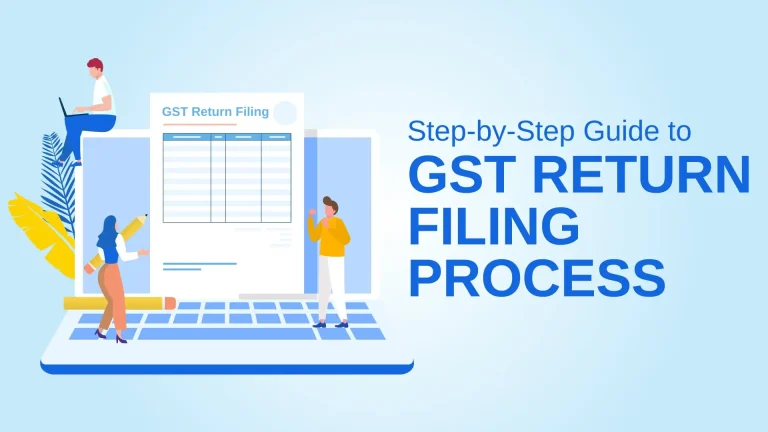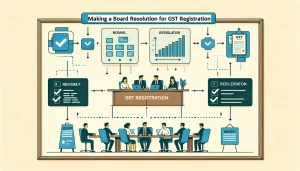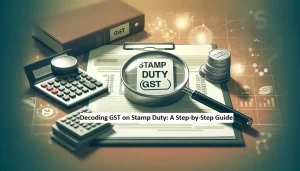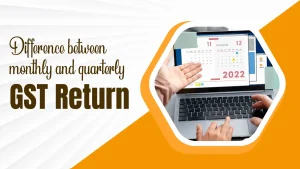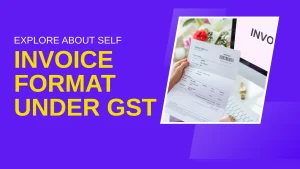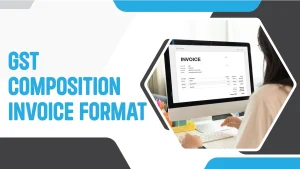In today’s fast-paced business world, it’s essential for every company to follow tax rules. One significant tax system in India is Goods and Services Tax (GST). Its goal is to make taxes simpler and more consistent across the country’s economy. For businesses under GST, submitting accurate and timely returns is vital. This ensures they don’t face fines and keep a positive relationship with tax authorities. In this detailed guide, we’ll take you through GST return filing process step by step process. Our aim is to help you grasp your responsibilities and meet them smoothly.
Understanding GST Returns
GST returns are like reports where you jot down all your earnings, spending, and other money-related stuff. These reports need to be sent to the tax folks regularly. Why? Because they help you tell the government how much tax you owe them. How often you send these reports and what they contain depends on what kind of business you run and how much money you make. So, before you start filling in those forms, it’s crucial to have a clear grasp of what GST returns are and why they matter.
Types of GST Returns
Under the Goods and Services Tax (GST) regime, there are various kinds of returns meant for different types of taxpayers and transactions. These returns serve as reports that businesses submit to the government, detailing their sales, purchases, and tax payments. Understanding these return types is essential for businesses to fulfill their tax obligations accurately and on time.
The primary types of GST returns encompass a range of reporting requirements tailored to various businesses:
GSTR-1
GSTR-1, also known as the Goods and Services Tax Return-1, is a crucial document that taxpayers need to submit either monthly or quarterly, depending on their turnover. This return primarily focuses on recording all the sales transactions made by the taxpayer during the specific period. It covers a variety of details such as invoices issued to customers, credit notes issued for any refunds or adjustments, debit notes reflecting additional charges, and any amendments or corrections made to previously submitted information.
This return serves as a comprehensive record of all outward supplies, providing authorities with a clear picture of the taxpayer’s sales activities. By including details like invoices, credit notes, and debit notes, it ensures transparency and accuracy in reporting sales transactions. Additionally, any changes or updates to previously furnished information can be reflected in this return, allowing for the maintenance of up-to-date records.
GSTR-3B
GSTR-3B is a monthly self-declaration return where taxpayers summarize their outward supplies, which are the goods or services sold, and inward supplies, which are the goods or services purchased. Additionally, they mention the Input Tax Credit (ITC) claimed, which is the tax already paid on purchases and can be deducted from the total tax liability. This return also includes the tax liability, which is the amount of tax owed to the government. It’s called a provisional return because it’s filed by taxpayers every month to fulfill their tax duties until a final return is submitted. This process helps taxpayers keep track of their tax obligations regularly and ensures compliance with GST regulations.
GSTR-4
GSTR-4 is a kind of report that certain businesses use to tell the government about their activities every three months. These businesses are part of what’s called the Composition Scheme. This report gives a summary of what they sold, how much tax they need to pay, and if they’ve already paid it. It’s like putting together all the information about their sales and taxes in one place, so the government knows what’s going on. For businesses in this scheme, it’s an important way to keep everything organized and make sure they’re following the rules.
GSTR-9
GSTR-9 is like the big yearly report card for businesses under the GST regime. It’s an annual return where you summarize all your GST-related activities for the entire financial year. Imagine it as a comprehensive overview that brings together all the details from the monthly or quarterly returns you’ve filed throughout the year. This includes everything from your sales and purchases to the taxes you’ve paid and collected. So, when you sit down to fill out your GSTR-9, it’s like painting a full picture of your business’s GST journey for the past year. It’s an important document that helps tax authorities understand your business’s financial transactions and ensure that everything is in order.
GSTR-9C
GSTR-9C is a crucial reconciliation statement that accompanies the audit report. It’s required for taxpayers whose turnover surpasses a certain limit, and it must be filed annually. What it does is pretty straightforward: it compares the information provided in GSTR-9 with the audited financial statements. This reconciliation process ensures that the figures reported in both documents align accurately, maintaining consistency and transparency in your tax reporting. Essentially, it’s a way to double-check and confirm that your GST returns match up with your financial records as verified by an independent auditor.
Step-by-Step Guide to GST Return Filing Process
Now that we’ve got a grip on what GST returns are all about and the various types out there, let’s roll up our sleeves and break down what is the gst return filing process step by step:
Step 1: Registration
The initial step in filing your GST return is making sure you’re registered under the GST regime. If you haven’t done this yet, you’ll need to go through the GST registration process. This can be done on the GST portal. It involves providing all the required information and documents. These documents are essential as they verify your identity and ensure that you’re recognized by the GST system as a taxpayer. Once you’re registered, you’ll be assigned a unique GSTIN (Goods and Services Tax Identification Number), which you’ll use for all your GST-related transactions and filings. Make sure to double-check all the details you provide during registration to avoid any issues later on.
Step 2: Maintain Proper Records
Once you’ve completed your registration, it’s really important to keep good records of everything you buy and sell. This means keeping track of what you’ve bought from others (inward supplies) and what you’ve sold to others (outward supplies). You’ll also need to keep records of all your invoices, bills of supply (if applicable), debit notes, credit notes, and any other papers that are important for your business transactions. Having these records in order is super important because it helps you make sure that when you file your GST returns, you’re doing it with the right information. So, basically, keeping good records is like having a map that guides you through the whole GST process, making sure you’re on the right track and not missing anything important.
Step 3: Determine the Filing Frequency
The next thing to figure out is how often you need to do your GST returns. This depends on how much business you’re doing and what kind of registration you have. Some folks file every month, some every three months, and some just once a year. It all depends on what’s going on with your business and how much you’re dealing with. So, take a good look at your situation to figure out the best schedule for you.
Step 4: Prepare the Return
Before proceeding to file your GST return, it’s crucial to make sure you have all the required information and documents ready. This includes details like your sales (outward supplies), purchases (inward supplies), input tax credit claimed, and the amount of tax you owe or are owed. To simplify this process, consider using accounting software or specialized GST filing tools. These tools help organize your data and ensure accuracy when preparing your return. By inputting all the necessary information correctly, you can avoid errors and ensure compliance with GST regulations. So, take your time to gather everything you need before starting the filing process.
Step 5: Validate and Submit
After you’ve finished preparing the return, it’s important to double-check all the details to make sure they’re correct and follow GST rules. Once you’ve confirmed everything is in order, you can submit the return on the GST portal using your registered login details. Once you’ve sent it off, you’ll get a confirmation or a special reference number (ARN) to show that your return has been successfully filed. This acknowledgment is like a receipt that lets you know your submission went through without any problems. It’s a crucial step to ensure that your tax filing process is complete and compliant with the GST regulations.
Step 6: Payment of Tax
If, after you’ve filed your return, there’s still some tax you owe, you need to pay it through the GST portal. This is done using a specific form called a challan. It’s important to make this payment on time to avoid facing extra charges like interest or penalties. Timely payment ensures you stay in good standing with the tax authorities and avoids any unnecessary financial burdens down the line. So, always double-check your tax liabilities and make sure to settle them promptly using the GST portal and the correct challan form.
Step 7: Reconciliation and Rectification
After you’ve finished filing your return, it’s important to regularly check the information you’ve provided against your financial records. This means comparing what you’ve declared for GST with what’s in your company’s financial documents. If you find any differences or mistakes, it’s crucial to fix them quickly. You might need to submit a corrected return to make sure everything is accurate and up-to-date. Checking and fixing any errors ensures that your tax reporting is correct and follows the rules set by the government. It’s all about making sure your business stays on track with its taxes and avoids any unnecessary issues down the line.
Advanced Strategies for Seamless GST Compliance
While understanding the basic steps of GST return filing is crucial, implementing advanced strategies can further enhance your compliance process and streamline your tax-related operations. Here are some advanced strategies to consider:
1. Automation and Integration
Investing in automation tools and integrating your accounting systems with GST filing software can significantly streamline the return filing process. Automated software can capture transaction data, reconcile it with your financial records, and generate GST returns with minimal manual intervention. This not only saves time but also reduces the risk of errors and ensures greater accuracy in filing.
2. Regular Reconciliation
Rather than waiting until the time of filing returns, adopt a proactive approach to reconciliation by conducting regular reviews of your financial data vis-à-vis GST returns. This helps in identifying discrepancies or mismatches early on, allowing you to rectify them promptly and maintain accurate records.
3. Stay Updated with GST Regulations
GST laws and regulations are subject to periodic changes and updates by the government. It’s crucial to stay abreast of these changes and ensure that your business practices and systems are aligned with the latest GST provisions. Subscribe to official GST updates and notifications to stay informed about any changes that may impact your compliance obligations.
4. Engage Professional Assistance
For complex businesses or those with extensive operations, seeking professional assistance from chartered accountants or GST consultants can be beneficial. These experts can provide insights into optimizing your tax structure, identifying eligible input tax credits, and ensuring full compliance with GST regulations. Their expertise can help navigate through intricate GST provisions and mitigate any potential compliance risks.
5. Implement Internal Controls
Establish robust internal controls within your organization to monitor and manage GST-related activities effectively. This includes segregating duties, maintaining proper documentation, conducting periodic audits, and implementing software controls to prevent errors or fraudulent activities. Internal controls not only ensure compliance but also instill confidence in the accuracy and integrity of your tax reporting.
6. Leverage Government Initiatives
Explore various initiatives and platforms introduced by the government to facilitate GST compliance, such as GSTN (Goods and Services Tax Network) and GST Suvidha Providers (GSPs). These platforms offer a range of services, including filing assistance, reconciliation tools, and compliance solutions, to simplify the GST compliance process for taxpayers.
7. Educate and Train Employees
Ensure that your employees, especially those involved in finance and accounting functions, are well-trained and educated about GST laws and compliance requirements. Conduct regular training sessions to update them on any changes in GST regulations, filing procedures, and best practices for maintaining compliance.
By implementing these advanced strategies, businesses can not only streamline their GST compliance process but also enhance efficiency, accuracy, and transparency in their tax-related operations. Remember, staying compliant with GST regulations is not just a legal obligation but also a fundamental aspect of responsible business conduct in the modern economic landscape.
Also Read:
- A Simple Guide to Making a Board Resolution for GST RegistrationRegistering for Goods and Services Tax (GST) is an essential step for businesses in India. This step not only ensures compliance with the law but also boosts the credibility of a business and opens up broader opportunities. One important part… Read more: A Simple Guide to Making a Board Resolution for GST Registration
- Decoding GST on Stamp Duty: A Step-by-Step GuideUnderstanding how GST (Goods and Services Tax) and stamp duty work together can be quite challenging. Both are very important parts of the Indian taxation system and have a significant impact on various financial transactions, especially in the real estate… Read more: Decoding GST on Stamp Duty: A Step-by-Step Guide
- Difference Between Monthly and Quarterly GST ReturnUnderstanding and complying with Goods and Services Tax (GST) requirements in India involves choosing how often you file your GST returns—monthly or quarterly. This decision is crucial for managing cash flow, meeting compliance obligations, and running your business smoothly. In… Read more: Difference Between Monthly and Quarterly GST Return
- Easy GST Return Filing Services: Simplifying Your Tax NeedsThe introduction of the Goods and Services Tax (GST) in India has brought about a unified tax regime, replacing a multitude of indirect taxes previously levied by the central and state governments. While GST has simplified the tax structure, filing… Read more: Easy GST Return Filing Services: Simplifying Your Tax Needs
Frequently Asked Questions
What is GST return filing?
GST return filing is the process of submitting details of your business transactions, including sales, purchases, and tax payments, to the government for taxation purposes.
Who needs to file GST returns?
Any business registered under the GST regime, including manufacturers, traders, and service providers, needs to file GST returns regularly.
How often do I need to file GST returns?
The frequency of GST return filing depends on factors like your turnover and registration type, and it can be monthly, quarterly, or annually.
What happens if I don’t file GST returns?
Failure to file GST returns can result in penalties and fines imposed by the tax authorities, along with potential legal consequences.
Can I revise my GST returns?
Yes, you can revise GST returns within a specified time period if you discover any errors or discrepancies in the original filing.
Do I need to pay taxes while filing GST returns?
Yes, you need to pay taxes on the supplies made by your business and claim input tax credit on eligible purchases while filing GST returns.
What documents do I need for GST return filing?
You need to maintain records of invoices, bills of supply, debit/credit notes, and other relevant documents to support your GST return filing.
Can I file GST returns online?
Yes, GST returns can be filed online through the GST portal using your registered credentials and digital signature, if applicable.
What is GSTR-9 and when do I need to file it?
GSTR-9 is an annual return that summarizes your GST activities for the financial year, and it needs to be filed by certain taxpayers by a specified deadline.
Where can I get help with GST return filing?
You can seek assistance from GST consultants, chartered accountants, or use GST filing software available on the market to simplify the process and ensure compliance.

